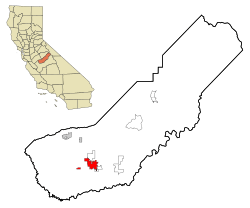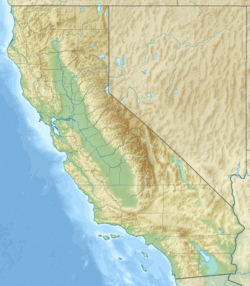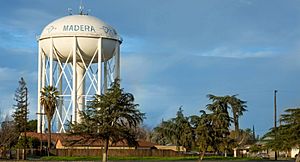Madera, California facts for kids
Quick facts for kids
Madera, California
|
|
|---|---|

Aerial view of Madera
|
|
| Nickname(s):
"The Heart of California"
|
|

Location in Madera County and the state of California
|
|
| Country | United States |
| State | California |
| County | Madera |
| Regions | Central Valley Northern California |
| Incorporated | March 27, 1907 |
| Government | |
| • Type | Council and Manager |
| Area | |
| • City | 16.48 sq mi (42.67 km2) |
| • Land | 16.48 sq mi (42.67 km2) |
| • Water | 0.00 sq mi (0.00 km2) 0% |
| Elevation | 272 ft (83 m) |
| Population
(2020)
|
|
| • City | 66,224 |
| • Density | 4,018.4/sq mi (1,552.00/km2) |
| • Metro | 152,465 |
| Demonym(s) | Maderan |
| Time zone | UTC−8 (Pacific) |
| • Summer (DST) | UTC−7 (PDT) |
| ZIP codes |
93636–93639
|
| Area code | 559 |
| FIPS code | 06-45022 |
| GNIS feature IDs | 277552, 2410906 |
Madera (Spanish for "Wood") is a city and county seat of Madera County, located in the San Joaquin Valley of California. As of the 2020 United States census, the city's population was 66,224.
Contents
History
The town was named after the Spanish term for lumber. The town was laid out by the California Lumber Company in 1876. From 1876 to 1931, a 63-mile (101 km) water flume carried lumber from the mountains to Madera, where the lumber was shipped by train.
The first post office at Madera opened in 1877. On May 16, 1893, Madera County officially became a county of the state of California and the town incorporated as the City of Madera on March 27, 1907. One of the city's first African Americans to hold an elected office was Rev. Naaman N. Haynes, who was voted in as a Madera Unified School District school board trustee in the 1960s.
Landmarks include the historic Madera County Courthouse, the notable Madera water tower, and a fully operational drive-in movie theater.
Geography
Madera is located at 36°57′41″N 120°03′39″W / 36.96139°N 120.06083°W. The geographic center of California is 38 mi (61 km) east of Madera. Via California Route 99, the city is 23 miles (37 km) northwest of Fresno and 72 miles (116 km) southeast of Modesto. According to the United States Census Bureau, Madera has a total area of 16.5 square miles (43 km2), all of it recorded as land. The Fresno River, a tributary of the San Joaquin River, passes through the city north of downtown.
Madera is the location of the Madera AVA wine region.
Climate
Madera has a steppe climate (Köppen: BSk), in the central zone of this climatic subtype. Annually, there are an average of 108.6 afternoons with highs of 90 °F (32 °C) or higher, 29.6 afternoons reaching or exceeding 100 °F (38 °C), and an average of 25.1 mornings with lows of 32 °F (0 °C) or lower. The record high temperature was 116 °F (47 °C), recorded on July 13, 1961. The record low temperature was 15 °F (−9 °C), recorded on January 10, 1949.
The average annual rainfall is 10.79 inches (274.1 mm) and there is an average of 59.3 days with measurable precipitation. The wettest year was 1983, with 22.13 inches (562.1 mm) and the driest was 2013, with 4.49 inches (114.0 mm). The most rainfall in one month was 7.11 inches (180.6 mm), in March 1991. The most rainfall in 24 hours was 1.98 inches (50.3 mm), on November 21, 1978. Although snowfall is rare, 4.0 inches (10 cm) fell in January 1962.
| Climate data for Madera, California (Madera Municipal Airport), 1991–2020 normals, extremes 1928–present | |||||||||||||
|---|---|---|---|---|---|---|---|---|---|---|---|---|---|
| Month | Jan | Feb | Mar | Apr | May | Jun | Jul | Aug | Sep | Oct | Nov | Dec | Year |
| Record high °F (°C) | 77 (25) |
83 (28) |
91 (33) |
99 (37) |
107 (42) |
115 (46) |
116 (47) |
113 (45) |
115 (46) |
105 (41) |
92 (33) |
76 (24) |
116 (47) |
| Mean maximum °F (°C) | 67.3 (19.6) |
72.6 (22.6) |
80.8 (27.1) |
89.8 (32.1) |
98.2 (36.8) |
104.2 (40.1) |
105.8 (41.0) |
105.3 (40.7) |
102.3 (39.1) |
93.1 (33.9) |
78.7 (25.9) |
66.9 (19.4) |
107.4 (41.9) |
| Mean daily maximum °F (°C) | 56.9 (13.8) |
62.6 (17.0) |
68.5 (20.3) |
75.0 (23.9) |
83.9 (28.8) |
92.2 (33.4) |
97.7 (36.5) |
96.7 (35.9) |
91.7 (33.2) |
80.1 (26.7) |
66.4 (19.1) |
56.3 (13.5) |
77.3 (25.2) |
| Daily mean °F (°C) | 47.8 (8.8) |
51.7 (10.9) |
56.1 (13.4) |
60.7 (15.9) |
68.1 (20.1) |
75.0 (23.9) |
80.2 (26.8) |
79.0 (26.1) |
74.8 (23.8) |
65.0 (18.3) |
54.1 (12.3) |
46.9 (8.3) |
63.3 (17.4) |
| Mean daily minimum °F (°C) | 38.6 (3.7) |
40.8 (4.9) |
43.7 (6.5) |
46.4 (8.0) |
52.3 (11.3) |
57.9 (14.4) |
62.6 (17.0) |
61.3 (16.3) |
57.8 (14.3) |
49.8 (9.9) |
41.8 (5.4) |
37.6 (3.1) |
49.2 (9.6) |
| Mean minimum °F (°C) | 27.9 (−2.3) |
30.3 (−0.9) |
33.6 (0.9) |
36.6 (2.6) |
43.6 (6.4) |
48.7 (9.3) |
55.3 (12.9) |
54.5 (12.5) |
48.7 (9.3) |
39.3 (4.1) |
30.7 (−0.7) |
27.2 (−2.7) |
25.4 (−3.7) |
| Record low °F (°C) | 15 (−9) |
21 (−6) |
24 (−4) |
29 (−2) |
33 (1) |
38 (3) |
42 (6) |
41 (5) |
34 (1) |
24 (−4) |
22 (−6) |
16 (−9) |
15 (−9) |
| Average precipitation inches (mm) | 2.08 (53) |
1.99 (51) |
1.98 (50) |
0.89 (23) |
0.47 (12) |
0.16 (4.1) |
0.01 (0.25) |
0.00 (0.00) |
0.03 (0.76) |
0.44 (11) |
0.92 (23) |
1.82 (46) |
10.79 (274.11) |
| Average precipitation days (≥ 0.01 in) | 10.0 | 10.6 | 8.9 | 5.0 | 2.2 | 0.5 | 0.1 | 0.1 | 0.6 | 2.6 | 7.4 | 10.2 | 58.2 |
| Source 1: NOAA | |||||||||||||
| Source 2: National Weather Service | |||||||||||||
Demographics
| Historical population | |||
|---|---|---|---|
| Census | Pop. | %± | |
| 1880 | 217 | — | |
| 1890 | 950 | 337.8% | |
| 1910 | 2,404 | — | |
| 1920 | 3,444 | 43.3% | |
| 1930 | 4,665 | 35.5% | |
| 1940 | 6,457 | 38.4% | |
| 1950 | 10,497 | 62.6% | |
| 1960 | 14,430 | 37.5% | |
| 1970 | 16,044 | 11.2% | |
| 1980 | 21,732 | 35.5% | |
| 1990 | 29,281 | 34.7% | |
| 2000 | 43,207 | 47.6% | |
| 2010 | 61,416 | 42.1% | |
| 2020 | 66,224 | 7.8% | |
| U.S. Decennial Census | |||
2010
The 2010 United States Census reported that Madera had a population of 61,416. The population density was 3,889.7 inhabitants per square mile (1,501.8/km2). The racial makeup of Madera was 30,640 (49.9%) White, 2,069 (3.4%) African American, 1,933 (3.1%) Native American, 1,369 (2.2%) Asian, 72 (0.1%) Pacific Islander, 22,603 (36.8%) from other races, and 2,730 (4.4%) from two or more races. Hispanic or Latino of any race accounted for 47,103 people (76.7% of the population).
The Census reported that 60,825 people (99.0% of the population) lived in households, 418 (0.7%) lived in non-institutionalized group quarters, and 173 (0.3%) were institutionalized.
There were 15,938 households, out of which 9,003 (56.5%) had children under the age of 18 living in them, 8,521 (53.5%) were opposite-sex married couples living together, 2,917 (18.3%) had a female householder with no husband present, 1,450 (9.1%) had a male householder with no wife present. There were 1,323 (8.3%) unmarried opposite-sex partnerships, and 97 (0.6%) same-sex married couples or partnerships. 2,374 households (14.9%) were made up of individuals, and 1,077 (6.8%) had someone living alone who was 65 years of age or older. The average household size was 3.82. There were 12,888 families (80.9% of all households); the average family size was 4.09.
The population was spread out, with 21,338 people (34.7%) under the age of 18, 7,732 people (12.6%) aged 18 to 24, 17,287 people (28.1%) aged 25 to 44, 10,407 people (16.9%) aged 45 to 64, and 4,652 people (7.6%) who were 65 years of age or older. The median age was 26.6 years. For every 100 females, there were 104.0 males. For every 100 females age 18 and over, there were 103.3 males.
There were 17,049 housing units at an average density of 1,079.8 per square mile (416.9/km2), of which 8,096 (50.8%) were owner-occupied, and 7,842 (49.2%) were occupied by renters. The homeowner vacancy rate was 3.5%; the rental vacancy rate was 5.1%. 28,785 people (46.9% of the population) lived in owner-occupied housing units and 32,040 people (52.2%) lived in rental housing units.
2000
As of the census of 2000, there were 43,207 people, 11,978 households, and 9,438 families residing in the city. The population density was 3,515.3 inhabitants per square mile (1,357.3/km2). There were 12,521 housing units at an average density of 1,018.7 per square mile (393.3/km2). The racial makeup of the city was 48.2% White, 3.9% African American, 2.8% Native American, 1.4% Asian, 0.1% Pacific Islander, 38.0% from other races, and 5.7% from two or more races. Hispanic or Latino of any race were 67.8% of the population.
There were 11,978 households, out of which 48.4% had children under the age of 18 living with them, 53.7% were married couples living together, 17.5% had a female householder with no husband present, and 21.2% were non-families. 16.8% of all households were made up of individuals, and 7.9% had someone living alone who was 65 years of age or older. The average household size was 3.57 and the average family size was 3.90.
In the city, the population was spread out, with 35.4% under the age of 18, 12.5% from 18 to 24, 28.3% from 25 to 44, 14.9% from 45 to 64, and 8.8% who were 65 years of age or older. The median age was 26 years. For every 100 females, there were 102.8 males. For every 100 females age 18 and over, there were 101.1 males.
The median income for a household in the city was $31,033, and the median income for a family was $31,927. Males had a median income of $29,776 versus $23,210 for females. The per capita income for the city was $11,674. About 25.6% of families and 32.5% of the population were below the poverty line, including 40.0% of those under age 18 and 12.7% of those age 65 or over.
Current estimates
According to estimates by the US Census Bureau from July 1, 2019, the total population for the city of Madera was 65,860, and the median household income was $42,581.
Education
- School districts
- Madera Unified School District (K-12)
- High schools
- Madera High School
- Madera South High School
- Matilda Torres High School
- Alternative Education Schools
- Furman Independent Study
- Mountain Vista High School
- Ripperdan Community Day School
- Madera County Superintendent of Schools
- Endeavor/Voyager
- Madera County Independent Academy
- Pioneer Technical Center
- Private schools
- Saint Joachim School (preK-8)
- Crossroads Christian School (preK-8)
- Higher education
- Madera Community College
- San Joaquin Valley College Madera (for-profit)
- Public libraries
- Madera County Public Library
Transportation
Within the city, State Route 99 carries traffic in a generally northwest–southeast orientation. East of the city, State Route 41 can be accessed via either eastbound county roads or via State Route 145, the latter of which turns from a northeast–southwest bearing to a directly southern orientation within the city. The eastern terminus of State Route 152 is located 10 miles (16 km) to the north of the city, on State Route 99.
Just north of Madera is the Madera Amtrak station. A California High-Speed Rail stop is also planned.
There is a Greyhound bus station located downtown.
The city of Madera provides local intracity public transportation services under the Madera Metro branding. Madera residents can travel conveniently from neighborhoods to shopping centers, local schools, medical offices and work sites on the Madera Metro fixed-route transit services. Madera County Connection, a county agency, provides intercity bus services to other communities in Madera County.
Madera Municipal Airport is a general aviation airport owned and operated by the city of Madera. It is situated on approximately 524 acres (2.12 km2) on the northwest edge of the city and is supervised by the Madera Public Works Department. Madera residents also have access to the nearby Yosemite International Airport, located in Fresno.
Notable people
Noteworthy persons from Madera include:
- Frank Bergon, author of four novels, including Jesse's Ghost (2011) which is set in Madera
- Connor Brogdon, pitcher for the Philadelphia Phillies
- Dwayne Crump, defensive back for the St. Louis Cardinals
- Lee Evans (1947–2021), Olympic gold medalist and former world record holder in track and field
- Zoila Frausto Gurgel, women's mixed martial arts champion
- Lavar Johnson, American mixed martial artist who competed as a heavyweight for the Ultimate Fighting Championship (UFC)
- Jack W. Kelso (1934–1952), Medal of Honor recipient
- Oswaldo Lopez, winner of the 2011 Badwater Ultramarathon
- Frank McNally, all-pro football player
- Wally O'Connor, four-time Olympian in water polo & swimming and 1924 gold medalist
- Jeannine Riley, actress and star of Petticoat Junction
- Martha Baird Rockefeller, concert pianist, philanthropist, and wife of John D. Rockefeller Jr.
- Kathryn Grove Shipp (1904–1977), explosives expert; raised in Madera
- Avery Stafford, gospel and R&B vocalist
- Virginia Stroud, painter and former Miss Indian America
- La Schelle Tarver, outfielder for the Boston Red Sox
- Lorin Whitney, organist and recording artist
- Leroy Zimmerman, All-Pro professional football player, Hall of Fame softball pitcher, and teacher
Sister cities
 Yilan City, Yilan County, Taiwan (1994)
Yilan City, Yilan County, Taiwan (1994)
See also
 In Spanish: Madera (California) para niños
In Spanish: Madera (California) para niños






